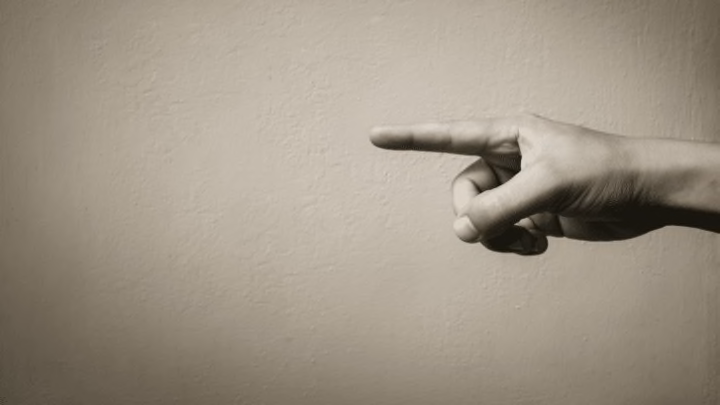Sociopaths and narcissists may believe they have lying down to a science, but it turns out there are a lot of little clues that reveal even the most sophisticated level of mendacity. If you want to catch a liar in their tracks, look for the following "tells," courtesy of father and daughter Dan and Lisa Ribacoff, credibility assessment experts and advanced certified polygraph examiners based in New York. They use their skills in criminal investigations, business matters, family and relationship issues, and other areas; you might have seen them on TV. Dan is also a private investigator.
The Ribacoffs use a mix of psychology, body-language analysis, expert interview skills, and polygraph tests to determine whether someone is lying. A polygraph is a combination of medical devices that monitor any physiological changes, particularly heart rate, blood pressure, respiratory rate, and perspiration rate, that an interview subject undergoes during an interview. To begin this process, the examiner conducts a pretest interview, asking questions that should be easy for the subject to answer, such as name and age. This establishes a "baseline" of normal autonomic responses to benign questions. They may also do a "stimulation test" in which the subject is asked to lie consciously. Changes from the baseline may indicate deception—though that interpretation is up to the examiner.
The accuracy of polygraph tests has been questioned by numerous critics, including the American Psychological Association. Guilty people have passed them, and innocent people have failed them. But they're just one factor in the Ribacoffs' assessments, which are based mostly on reading people, not polygraphs.
Credibility assessment is not built upon a single tell but a combination, Dan tells Mental Floss: "There's not one verbal or non-verbal cue that is going to be the absolute indicator [of a lie]. It's a process of collecting pieces to the puzzle and putting that puzzle together."
Read on for tips to identify when someone might be lying to you.
1. THEY CREATE PHYSICAL DISTANCE.
A common habit for a person obfuscating the truth is to put physical distance between themselves and the person they're lying to, particularly if they're being questioned. "Sitting back and stretching your legs out is trying to gain distance between you and the interviewer," Dan says. Crossing one's arms, a defensive posture, is also a potential sign of duplicity.
2. THEY FIDGET.
Because lying activates the limbic system, whose goal is to keep you calm under stress, liars may have a hard time sitting still. "It's like the popcorn maker pops its lid [in your mind]," Dan says. "You do things to burn off nervous energy, like pick off imaginary lint, rub your arm—self-soothing behaviors such as moving or fidgeting." Lisa tells Mental Floss that "rubbing your neck or playing with hair" are also signs of potential deception, particularly if someone does it right after they lie to you.
3. THEY AVOID EYE CONTACT AT THE MOMENT OF UNTRUTH.

Eye contact is intimate, vulnerable—and lots of liars can't hold a gaze when they're working up a mistruth. Lisa says she's found that examinees will often maintain eye contact "right up until they give the answer they're lying about." The polygraph usually reveals physiological changes that suggest the person is lying. There are other reasons that a person might not make eye contact, such as being on the autism spectrum or having certain psychological disorders, but Dan says the baseline of normal behavior is established for each individual subject. What examiners look for is a change or departure from the person's unique baseline.
4. THEY ANSWER A QUESTION WITH A QUESTION.
A liar will not directly say they haven't done something wrong; they'll answer with a dodge, a question back at you, or a nonsequitor. Not answering directly is an immediate alarm bell to Dan. An innocent person will usually just say "no" when asked if they've done something wrong. "A guilty person has a hard time saying no," Dan says. When they don't answer the question, you might sniff out a lie.
5. THEY RAMBLE AND SHIFT BLAME.

Another surefire trick of the treacherous is to over-explain. "They hard sell it to you, they go off on tangents, they ramble," Dan says. "They give you unimportant information." Or, they'll shift the blame onto someone else.
Dan, who lends his expertise to The Steve Wilkos Show, recently assessed a situation where an employee of a hotel was accused of stealing money from a hotel room. He polygraphed the entire hotel security staff, because it involved taking money from a safe that only they would have access to. When Dan questioned the accused employee, the man proclaimed his innocence and shifted the blame to his manager, Kara, and another employee named John. "When I said, 'Did you take the money?' he said, ‘I didn't take the money, it's that goddamn Kara, she's constantly favoring this one guy John because she grew up with him, and he's her boy,'" Dan recalls.
But John passed the polygraph, while the employee—who was guilty—failed it.
6. THEY TELL A STORY THAT KEEPS CHANGING …
Liars also tend to change the story every time they tell it. In a recent case, Dan interviewed a man who was charged with stealing from his workplace and selling the items. He claimed to Dan that a security guard at the company had actually committed the crime. He even mentioned that he'd run into the security guard recently at a party. But conveniently, the man didn't know the guard's name or have his phone number. Lisa put him through a second interview, asking him the same questions, and "suddenly he knows the security guard's name and has his number," she says. This spelled a lie to Dan, and the polygraph results backed up his assessment.
7. … AND DOESN'T ADD UP.
"If the story doesn't make sense, it's usually not true," Dan says. In a recent case, a wife had agreed to take a polygraph at the request of her jealous husband, who had found numerous texts between her and a coworker on her phone. At first she told Dan that she and her colleague were merely friends who texted a lot, but that nothing physical happened between them. But as the polygraph went on, she added their communications went on for three years … and then confessed that they included nude photos of her.
She failed the polygraph—but then agreed to a second one, during which she denied having sexual contact with the friend. After she failed that test too, she admitted she had kissed the friend. (Even without these confessions, her body language throughout both tests was telling, Dan says; she was distraught and trembling. "I felt really bad for her," he admits. "I knew it wouldn't end well.")
"There's a saying: If it doesn't add up," Dan says, "it's usually because the truth wasn't in the equation."
8. THEY EXHIBIT FIGHT-OR-FLIGHT SYMPTOMS.

You breathe shallower when you lie, your face flushes, and you may begin to sweat. In addition, Dan says, "You lick your lips because digestion stops when fight or flight kicks in." Of course, these symptoms can also happen if you are genuinely afraid or have issues with authority, but according to Dan, this is where that valuable baseline of behavior helps an examiner determine if you were already nervous when you walked in.
Dan has one more tip that's useful no matter how astute your observational powers are: Get the person talking. He suggests approaching your line of questioning as an interview rather than an interrogation. "When I interview you, I let you talk," he notes. "In an interrogation, I'm doing the talking to get you to confess."